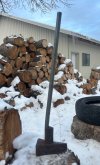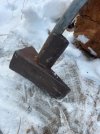- Joined
- Jan 18, 2025
- Messages
- 9
No, it's very much a maul. A hardened hammer face is not a prerequisite for a maul. It's also not that it's not designed to drive wedges, but rather a priority was placed on deformation over energy transfer--Council themselves call it a maul and do not tell you not to strike wedges with it. Similarly, when finishing a split with the poll it's still being used as a hammer. Your definition is overly narrow compared to the historical scope of the tool
I asked Craig Roost about it (or rather I asked about it in general and he answered me) and he said they recommend using a sledge hammer for wedges instead and that the reason they don't harden the poll is because they anticipate that their users will use the thing as a wedge, which is dangerous if both tools are hardened. A surrender in the perennial struggle for American axe manufacturers to get their American customers to not misuse their tools. I am sure you know that old American mauls, and new Finnish, German, Swedish, and Italian mauls all have hardened, functional, mauling polls, so it's still a bad idea to make a habit of using mauls as wedges if whatever striking implement used is hardened.
Using the poll to finish off a split is a good idea but squarely in axe territory, especially because it is tapered to work by wedging action, albeit with a very blunt wedge.
Anyway, the definition I use is specific, long standing, and not recently invented, subjective, vague, or convoluted like "priority is placed on deformation not energy transfer"; rather than being overly narrow it is based on the ordinary meaning of words in English, which also parallels the names of these tools in German (Spalthammer vs. Spaltaxt translates as splitting hammer vs. splitting axe), Swedish (klyvyxa and släggyxa translates as splitting axe and sledge axe), and other languages. Straightforwardly, an edged metal wedge mounted on the end of handle is some sort of 'axe' and a 'maul' means what it always has: a percussive driving tool shaped like a hammer or club. This is the dictionary definition. The Dictionary of Tools Used in the Woodworking and Allied Trades defines maul as "A term for various tools used for driving." The and last time I Googled it the main definition given in various places for the difference between an axe and a splitting maul is the latter's hardened poll. In the glossary of The Ax Book, Dudley Cook's definition for Maul is "Long handled hammer with wood-splitting bit also." The USFS One Moving Part axe manual says "splitting mauls and sledge hammers have hardened ends, so it is best to use one of these tools to drive metal splitting wedges or strike other metal surfaces". This follows what "maul" in general and 'splitting maul' in particular always meant at least until 70s or 80s, around the time when people also started hanging their dull axes upside down on fat handles after burning the old handle out of the eye in a back yard fire pit. Prior those dark ages, Plumb described their Constructor's axes (usually called a rafting pattern now) in the 1970 catalogue as "Has broad hardened head to withstand constant pounding. A maul and axe combined in one tool." True temper's 1957 catalogue entry for their constructor's axe says "Heads specially heat treated and tempered for use as a maul". In the Mann 1949 catalogue they call it a "mauling mattern" and on page 7 under axe defects they note "Axes are not designed or intended to be used as mauls or wedges". These catalogues aren't saying that you can't use a regular axe to split wood, they are saying that a regular axe is not meant to be used as a bludgeoning or driving tool by using the word 'maul' as they expected it to be understood by their customers.
Anyway, I have a couple mauls: an 8lb USM, an unstamped 6lb sledge eye (that one is my favourite, getting back to the topic), and a 6lb BNT (putting it in the 50s or 60s) and I intend to use the word maul in the same way it would have been understood by the people that made those tools.


